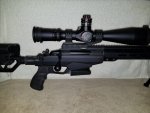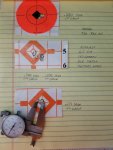TLDR: For virgin brass, focus on perfecting your technique (keeping variations in your brass prep LOW) and load a little over minimum to the middle of the recommended powder charges. Use these rounds to "break in" your barrel if you believe in that and practice good marksmanship fundamentals. Once fired brass is really recommended to be the start of your load development.
I did the same thing as you did.
I bought 300 pieces of Peterson brass, and did Saterlee's test and OCW. With an SD of 6/7 (I trimmed some pieces of brass too short I assume), I found that my nodes were between 41.4-41.6 and 42.3-42.6 with both the 10 round test and OCW.
Now, I wanted to have a high velocity, so I chose 42.4gr @ 2824fps verified over 60 rounds with the same SD's.
I then worked the magic on once fired brass and found that my FPS jumped considerably, with major pressure signs showing up. (I went from 2824 to 2860 with my once fired brass with heavy ejector marks.) As you might find after searching, most of the energy during fire forming virgin brass is used to expand the case, hence lower FPS/pressures. Once the case is somewhat fitted/resized to your chamber, you'll get the standard velocities you'll see for the rest of the barrel's life at those powder charges.
After scouring the web to find some sort of algorithm for nodes, and found one guy mentioning to subtract 0.8gr and I'd be somewhere around my next lowest node (41.6gr). Me being a skeptic/science geek, I noted that information but still went on to do another OCW test, this time with 42.4 as my max.
I found the same POI at 41.4-41.6 and settled on 41.5. Ironically, I loaded 3 rounds of 41.5gr as the center load to be my sight in shots. The group, measured at the center points with calipers, was a little over 1/4 MOA, while 41.4 and 41.6 was around 3/10 MOA.
If you really want, I can post the incredibly long journey I had developing my load.




